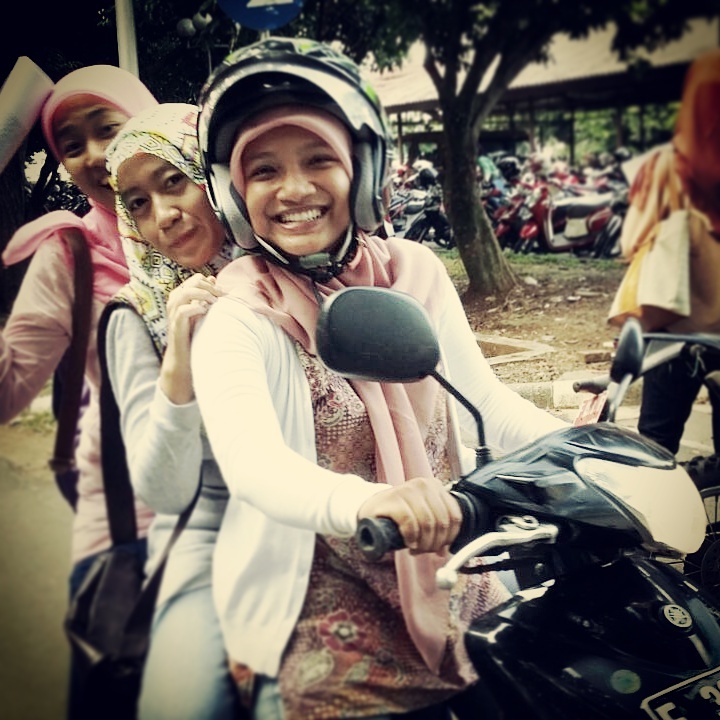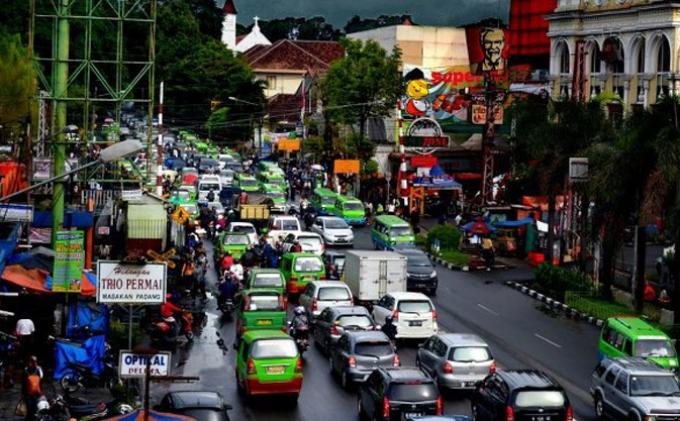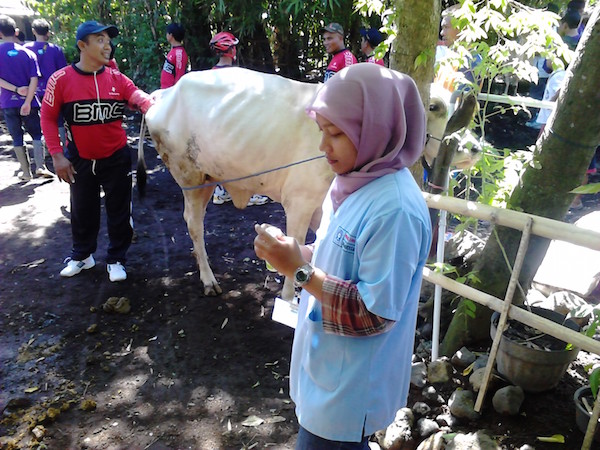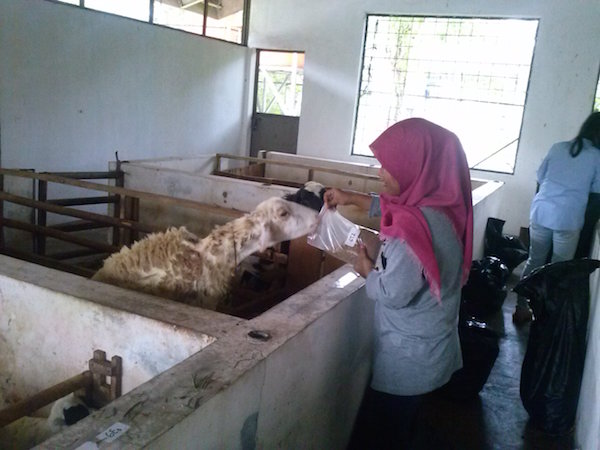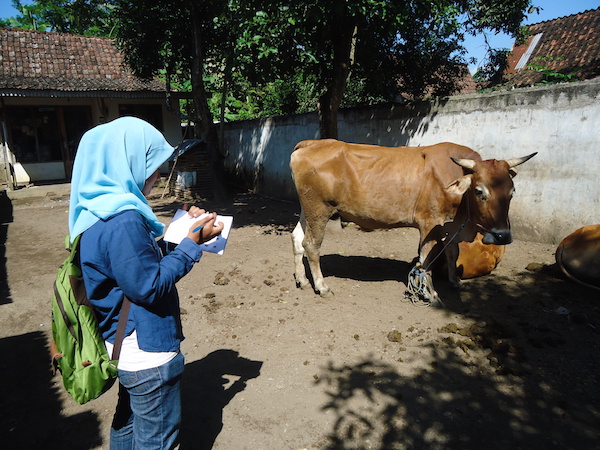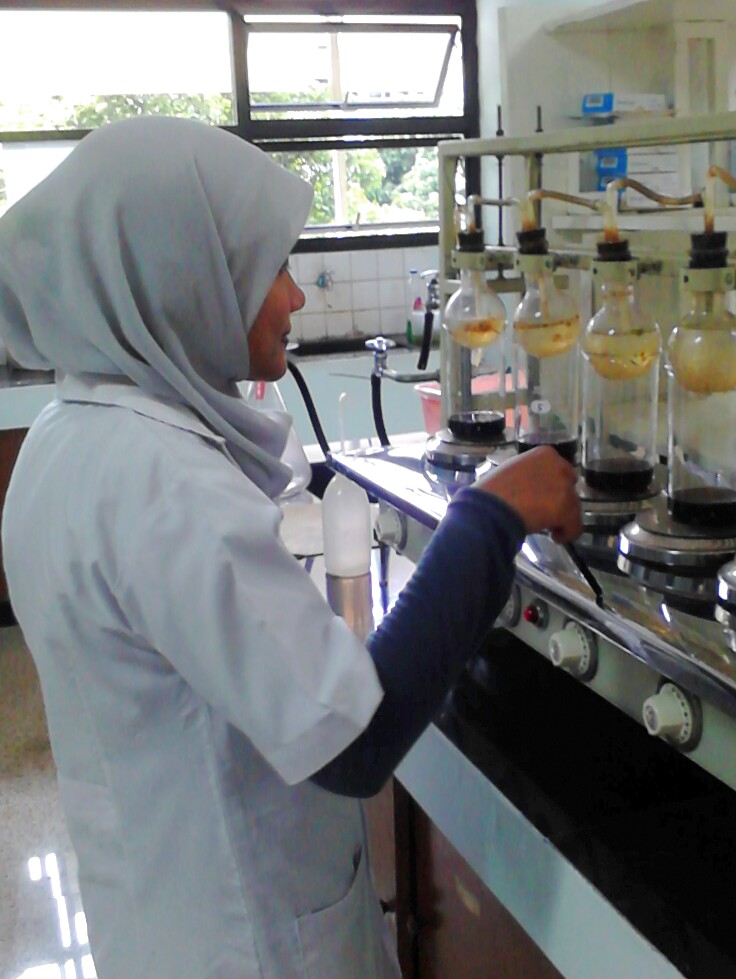From Indonesia to the Outback
Written by Febrina Prameswari – Student, Bogor Agricultural University.
Hi I’m Febrina Prameswari. I am 21 and I’m a student of Bogor Agricultural University (IPB) majoring in Animal Nutrition and Feed Technology in the Faculty of Animal Science. Hopefully this is my last year in University so I can graduate and get a job in the agricultural sector. I have no more classes so now I’m just drafting my thesis and writing my journal until my supervisors allow me to take my final exams.
I was living in Jakarta with my family before my family moved to a village in Bogor sub-district when I was in 2nd year of senior high school. I continued living with my aunty and grandparents in Jakarta until I finished school. My parents said “If you want to go to university you gotta get into State/Public University around Jakarta or not at all”. They said I had better continue going to Islamic boarding school for Koranic studies then find a job, because it’s unaffordable for them to pay the cost for a Private University or Public University that is out of the city for rent etc.
As a high school ‘city student’ it never crossed my mind to choose Animal Science major in University. I had never touched cattle or sheep or chickens or rabbits or horses before. I was so ambitious to apply for Communications, English Literature, French Literature, and International Relations in University of Indonesia several times but still I couldn’t make it. That Uni is like #1 uni in Indonesia for social majors. I actually applied for a Literature major and/or Social on my 1st year but my counselor told my parents that I should apply for science because the top 10 students in class will get into that one science class without the test, while other students had to pass the test first. They kept telling me that science students have a brighter future, but I love to learn foreign languages and social or art lessons. I was in Indonesian-Malaya Traditional dance (Saman) as an extracurricular activity in high-school. I’m not really good at maths or chemistry!
When I started to feel hopeless, I told my parents that I would try my last chance to take the long test to get into another Public University near home which is Bogor Agricultural Uni. With Communication for Rural Community Development and Environmental Economic majors, I didn’t even think I could pass the test. Bogor Ag Uni is the #1 Uni in Indonesia for Science majors. I didn’t know how I would pass the test into the Bogor Ag Uni, but I was accepted as an Animal Nutrition and Feed Technology Major student.
I still had no idea what I’d learn as I have no family background in livestock sector. I never had pets like a dog or cat, but that’s alright. I just didn’t want to work or get into boarding school while my friends were going to colleges (it’s so hard in Indonesia to find a good job with good money unless you hold a Bachelors Degree). Then the journey began.
I wasn’t studying in Animal Science Faculty in the first year. I had to study basic agriculture, basic science, and socio-economics with other students from different majors and different countries (international students) in the class. I learned lessons that everyone would think there’s nothing to do with animal science; calculus, sports, religion, sociology, English, Bahasa Indonesian, civics, etc. We had to pass this sorting year to not to be dropped out so we could enter the faculty. Hundreds of students dropped out but luckily I didn’t. All freshman students had to stay in the Uni dormitory/student resident for a year. This is four people in a room with different majors and from different provinces/state origin. Most of us started looking for some campus organizations based on interests (sports, martial arts, research/paper (science), choir/art/music, adventure, business, etc). I got into youth entrepreneurship organization for a year and enjoyed being on the committee in some campus events.
I finally made it into faculty of Animal Science with a couple semesters scholarship from a company (Pty Ltd) which I applied for in the 1st year. I wasn’t in dorm anymore; I went back home and used mini bus public transportation or motorbike scooter to go to Uni while most of my friends stayed at share houses around campus.
I got student orientation from the faculty for about a week. The seniors introduced us to the faculty including the labs and animal houses as well as describing the subjects I’d take and the rules, lectures, and building. I found not many Animal Science students came from Jakarta or other Indo big cities. It felt little bit scary at first about how could I make it go well because I was so afraid with animals. I remember I embarrassed myself in front of so many friends in orientations when I had to touch to the cattle, sheep, chickens, frogs, and rats, and I almost cried. I couldn’t be motivated enough by the Dean welcoming speech: “Animal Nutrition Science and Feed Technology major is the one and only in Indonesia that you should be proud of. The former minister of Agriculture and so many ministers or successful people in this country, even former presidents, were our alumni, your seniors.”
The seniors told us “You gotta be strong enough to be animal science students. This major is different than others. So many classes will start at 7am in the morning, finish at least at 3pm, with no absents. You might not have relaxing weekends but be making lab-practical reports. Sometimes you gotta stay up too late and wake up earlier in the dawn for practical in groups for feeding and giving baths to the cattle in animal house. You’ll get your hands dirty and you will smell bad”. They’re totally true, all proven by myself but I survived because I think if I can’t do what I love, I should love what I do. It’s harder than the first year but it’s not as bad as it seems. I still had time to hang out with friends, and sometimes, that’s all you need.
I woke up in the morning and went to Uni from home at 6am and finished class at about 4pm. Most of the students couldn’t straight go home after classes finished especially if we involved in any organizations. Those organizations would hold meetings in the evening so we did the class-tasks in the night but no organizations activities in exam week. Most of students in this University had no part time job because of the tight schedules. I literally didn’t get into any campus organizations in my 2nd and 3rd year but I took foreign language courses (Korean and Mandarin) and joined the committee for campus events or joint seminars.
The subjects that I got in 2nd year were the basic animal sciences: Statistics, Entrepreneurship, Climatology, Basic Soil Science, Principle of Nutrition, Feedstuff, Animal Nutrition Physiology, Pasture Management, Integration of Nutritional Process, Genetics, Production Technology of Poultry, Ruminant, and Dairy Animals. In 3rd year I got Management of Animal Tropics Health, Reproduction, Feed Industry and Management, Feed and Ration Formulating, Nutrition for working Animals, Poultry, and Dairy, Research Methodology, Microbiology, Feed Processing Technology, and some elective supporting courses from other majors (Agriculture Economics for Natural Resources, Business Communication, Advanced English). I still had to take subjects on my 4th year (7th semester) before doing research; Halal Products Management, Policy and Feed Quality Assurance, Strategic Planning for Forage Availability. Those subjects were very hard, especially in exam weeks. Some of the lecturers were nice, some of them not.
Almost every subject was followed by practical classes whether in the laboratory or animal house, mostly they were in the laboratory. There were not many animals in the University animal house (field laboratory) maybe about 15-20 cattle, 30-35 sheep, 500 chickens maximum. Sometimes once or twice in a semester we visited a feedmill industry, feedlot, intensive dairy farm, extensive house for Broiler chickens, wet market, and retail feed seller. I visited Sierad Produce Feed Industry in Banten, Indofeed home-Industry in Bogor, Badan Inseminasi Buatan (Artificial Insemination Institution) in Lembang Bandung, where they imported breeds from Australia such as Australian Limousine Cattle, Citra Agro Buana Semesta in Garut West Java (the place I got trained before I did student exchange in NT and their cattle imported from Australia), Dairy Farm Homestead KUNAK (Kawasan Usaha Peternakan) in Cibungbulang, and Mitra Tani Integrated Farm in Bogor sub-district as well.
Most of the farms I’ve visited maintain their animals in intensive system only one or two using semi (half)-intensive systems. The forage/grass is given by “cut and carry” system. They give more concentrates/rations for fattening programs. Mitra Tani Integrated farm that I visited, plants some organic vegetables like spinach, kangkung, and lettuce. They maintain hundreds of sheep, lele (freshwater cat fish), and about 40 cattle, both local and cross breeds. They use half of the dry manure of cattle and sheep for fertilizing the vegetables and half for sale to other farmers in the village. The rotten vegetables were fed to lele and the ruminants. Their feed is based on crop by-products and they make their own feed so they just buy the raw materials to cut the cost. They were focused in local sheep (Garut sheep) for their breeding and fattening programs. The sneak peak of animal selling is on Qurban day (Islamic holy day like Christmas or Easter) and Aqiqah (sacrifice for the Islamic new born baby). I even guided South Australian Ag Students and lecturers from Adelaide Uni, UQ Gatton Uni, Charles Sturt Uni, La Trobe Melbourne, and Uni of New England to this farm on their Indo Beef Tour.
In the end of 6th semester I joined the “IPB Goes to Field” Program in Bondowoso, East Java for two weeks to see how small farmers maintain their one to five head of local Limousine cattle in the traditional way. Sometimes families keep those one or two cattle inside the house, on the back which is the kitchen. I joined with vet students giving information about how the cage/animal house should be, manure should be cleaned or can be used as fertilizer for their corn farm (field), injection of vitamin B and and anti-worm tablets, and anti-flies spray.
After I finished my class-subject credits, I did research for my thesis. My thesis is about physiological responses and blood profile of ewe. In the middle of my research I joined an internship program in Northern Territory Cattle Station, Australia for two months so I took a semester break. I applied for it because I think I didn’t get enough practical experience in the field at Uni. Too many theories into the cells levels.
That experience was like a point of my life that makes me realize that livestock sector is so important for both countries. I got used to cattle, horses, dogs, and frogs. Many Aussie’s lives depend on their farm and the big Indonesia population needs meat supply. Indonesia is the big market for Australian business. Australia has such huge pastoral land mass and well managed breeding programs, not so many people living there as well, contrasting with what I am used to seeing in Indonesia. But ration/concentrates in NT is so expensive compared with Indonesia. In Indonesia we can use by-product crops to make a cheap and nutritious feed, but the population here depletes land for homestead that’s why Indonesia still needs Australian cattle.
I wonder if someday Indonesia could be cattle self sufficient by its good breeding practices, so mid-class people could eat beef more often. Besides Indonesia’s big population, I think the climate in this very tropical country could be the reason why the cattle productivity here not as good as in sub-tropical country. And Indonesian Universities should provide the students more field lesson followed behind the theories.

